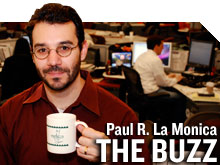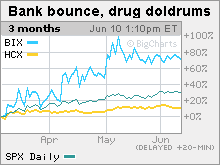Stocks the rally left behind
The market rally is now three months old. But stodgy sectors like health care and utilities are lagging. Still, abandoning 'defensive' stocks may not be a good idea.

 |
| The S&P 500 (SPX) has been on a nice run since March. But bank stocks (BIX) have outperformed the broader market by a wide margin while healthcare stocks (HCX) have lagged during the rally. |
NEW YORK (CNNMoney.com) -- Happy three-month birthday, stock market rally!
The S&P 500 finished on March 9 at 676.53, its lowest close of the year. (Technically, the market hit its nadir on March 6 when the S&P 500 hit the demonic level of 666.79. But you catch my drift.)
It's hard to believe that only three months ago investors were trying to figure out whether the economy, to paraphrase a frequent Stephen Colbert query to members of Congress, was heading for a Great Depression or the Greatest Depression.
Since March 10, it has been all blue skies as far as Wall Street is concerned. The S&P 500 is up more than 30%, and some sectors -- most notably banks, retailers and industrials -- have really soared on hopes that the worst is over.
To commemorate this quarter of a year anniversary, I thought it might be interesting to take a look at the stocks that have been left behind.
Talkback: Will bank stocks and retailers continue to rally or are they due to fall? Leave your comments at the bottom of this story.
Only nineteen companies in the S&P 500 are in this Land of Misfit Stocks, with six of the laggards residing in the healthcare sector. For example, drug and medical device makers Abbott Laboratories (ABT, Fortune 500) and Baxter International (BAX, Fortune 500) and biotech Cephalon (CEPH) have all fallen more than 5%
There are, of course, some individual reasons why these and the other healthcare firms have underperformed. But it makes sense that the sector hasn't participated in the rally.
For one, healthcare stocks held up a lot better when the market was tanking based on the notion that people still get sick in a recession and have to take care of themselves.
So healthcare is typically a defensive sector, one to own more of if you think the economy's reeling, and one of the first to get dumped when investors rush back into more cyclical industries like finance and tech.
But the debate in Washington over healthcare reform is adding to some of the uncertainty about the healthcare sector.
Healthcare stocks have historically been whipped around anytime there is talk of government-mandated change, and many believe that restructuring is finally in the offing (unlike Hillary Clinton's failed attempt at universal coverage in 1993-1994).
"Regulatory reform is a terrifying unknown threat which limits investors' enthusiasm for the sector. We saw it with 'HillaryCare' and now it looks like the probability of reform is higher," said Lawrence Creatura, a portfolio manager with Federated Clover Investment Advisors.
But healthcare stocks aren't the only losers. Interestingly, four S&P 500 companies from the supernova-hot financial sector are down since March.
The biggest laggard in the S&P 500 during the past three months is Cleveland-based bank KeyCorp (KEY, Fortune 500). This is a bit curious since Key is one of the banks that was found to need more capital following the government's stress tests -- and the other banks on that list have all surged on hopes that they have finally hit bottom.
Another bank that has lost ground is People's United Financial (PCBT), the opposite of KeyCorp. This regional bank, based in Bridgeport, Conn., is a rare breed in this environment: a healthy bank that isn't hated by consumers. People's is one of several regional banks to say no thanks to TARP. And in a recent J.D. Power survey, it was listed as having the highest customer satisfaction rating of all banks in New England.
So it could just be that the stock, which didn't get punished as severely as peers during the financial meltdown, may now be pulling back as investors return to more beaten down "bad" banks. Before the rally began in March, People's stock was down just 2.4% year-to-date compared to a 60% plunge in the S&P Banking Index.
In that respect, People's does appear to be part of a broader market trend. Stocks that didn't get crushed earlier this year are the ones pulling back now.
Education company Apollo Group (APOL), which surged late last year partly due to expectations that it could do well with unemployment rising as more people would seek to go back to school, is down 6%.
Shares of stodgy consumer companies like milk producer Dean Foods (DF, Fortune 500) and bargain retailer Family Dollar Stores (FDO, Fortune 500) are also down.
Finally, many utility stocks have also lagged the broader market's gains, although just one, FirstEnergy, has actually slipped during this rally.
Utilities tend to be defensive stocks as well. Earnings usually don't fall as sharply in economic slowdowns and the companies typically pay sizable dividends.
Now that economic recovery hopes are percolating, utilities look less attractive. Plus, long-term bond rate are marching higher, which also may steal some thunder from utilities. The U.S. 10-year note is yielding nearly 4%, up from a low of almost 2% in December.
"Bonds are providing competition for your typical income investor looking for yield. There has been a move away from utilities toward Treasurys," said Paul Nolte, director of investments for Hinsdale Associates, a money-management firm based in Hinsdale, Ill.
So with all this in mind, what should investors be doing now?
Both Creatura and Nolte think investors shouldn't completely ignore the recovery signs.
Creatura said his firm has been buying more materials and energy companies as a way to capitalize on growth hopes and increased commodity prices. And Nolte said tech stocks may be the best way to play an economic rebound.
But neither thinks it would be completely wise to dump all defensive investments and go all-in on a bet that the economy's going to surge back to life just like the stock market has.
Nolte said he's not willing to gamble that consumers are going to binge on credit and start spending recklessly again. For this reason, he's favoring healthcare stocks over retailers and banks.
"The markets have priced in a fairly robust recovery. But it's a surprise that the recession is being dismissed so quickly," Nolte said. "There are still scars in the economy and growth may be crimped because of consumer debt levels."
And Creatura noted that even if the economy does continue to recover, it's likely to be a bumpy rebound. Plus, many of the stocks that have risen so far so fast in the past three months are no longer bargains. Meanwhile, shares of some of the stocks left behind during the market's surge are trading at more attractive valuations.
"The fasten seat belt sign may be off for the economy but if you're seated you may still want to keep it buckled and look to some defensive stocks. And by the way they're relatively less expensive," Creatura said.
Talkback: Will bank stocks and retailers continue to rally or are they due to fall? ![]()

